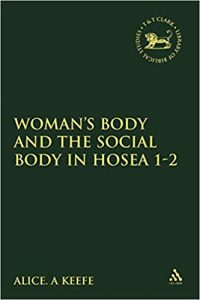Citando o artigo de Brad E. Kelle sobre Oseias 4-14, nas p. 337-338:
Since the 1980s, the traditional study of history and institutions has undergone one of the most significant reformulations in Hosea scholar ship, and within the current decade this reformulation has come to occupy a central place in the study of the book. Under the rising influence of social-science perspectives within biblical studies generally, the final years of the twentieth century and the beginning of the twenty-first century have witnessed the expansion of the kinds of study outlined above into a complex socio-economic/socio-materialist analysis of the background and dynamics that gave rise to and are reflected in the texts of Hosea. While there had been a relative dearth of major sociological studies of Hosea (but see Utzschneider 1980), several such comprehensive analyses have appeared within the last decade. Taken as a whole, these works focus on the primary metaphors in Hosea, especially sexual metaphors related to promiscuity, and interpret them as tropes for particular social and economic developments in eighth-century Israel and Judah. By drawing upon anthropological and sociological perspectives from the comparative study of agrarian societies, these newer approaches identify the eighth century as a time when Israel underwent a dramatic change in its economic system and modes of production due to the expansion of royal power at home and the demands of political and economic relations abroad. Israelite society experienced increased disparity between elites and peasants, the emergence of a tributary economy with royal land grants and cash-crops, and the growth of foreign trade. Hosea’s oracles and metaphors, it is argued, reflect these developments, especially the ways in which all other elements of the cult, politics, etc. became embodiments of the social crisis (…) Accordingly, Keefe (2001: 12) concludes that Hosea’s female and sexual imagery is a symbol of Israel’s disintegrating social body and the intertwined political, social, and religious aspects of the new royal economy.
Desde a década de 80 do século XX, o estudo tradicional da história e das instituições israelitas passou por uma das reformulações mais significativas nas abordagens acadêmicas  de Oseias. E na primeira década do século XXI essa reformulação passou a ocupar um lugar central no estudo do livro. Sob a crescente influência das perspectivas das ciências sociais nos estudos bíblicos em geral, os últimos anos do século XX e a primeira década do século XXI testemunharam o aparecimento de análises socioeconômicas para explicar o contexto do livro de Oseias. Tomados como um todo, esses trabalhos interpretam as metáforas mais significativas de Oseias, especialmente as metáforas sexuais relacionadas à promiscuidade, como figuras de linguagem para determinados desenvolvimentos sociais e econômicos em Israel no século VIII a.C. Baseando-se em perspectivas antropológicas e sociológicas do estudo comparativo das sociedades agrárias, essas novas abordagens identificam o século VIII a.C. como uma época em que Israel passou por uma mudança dramática em seu sistema econômico devido à expansão do poder real no território e à política externa implantada. A sociedade israelita experimentou um aumento da desigualdade entre a elite e os camponeses, viu o surgimento de uma economia tributária com concessões reais de terra e com a criação de culturas rentáveis e o crescimento do comércio exterior. Os oráculos e as metáforas de Oseias refletem esses desenvolvimentos, especialmente as maneiras pelas quais todos os outros elementos do culto, da política, etc. se tornaram personificações da crise social (…) Há autores, por exemplo, que interpretam as imagens da prostituição usadas no livro de Oseias como um símbolo do corpo social desintegrado de Israel.
de Oseias. E na primeira década do século XXI essa reformulação passou a ocupar um lugar central no estudo do livro. Sob a crescente influência das perspectivas das ciências sociais nos estudos bíblicos em geral, os últimos anos do século XX e a primeira década do século XXI testemunharam o aparecimento de análises socioeconômicas para explicar o contexto do livro de Oseias. Tomados como um todo, esses trabalhos interpretam as metáforas mais significativas de Oseias, especialmente as metáforas sexuais relacionadas à promiscuidade, como figuras de linguagem para determinados desenvolvimentos sociais e econômicos em Israel no século VIII a.C. Baseando-se em perspectivas antropológicas e sociológicas do estudo comparativo das sociedades agrárias, essas novas abordagens identificam o século VIII a.C. como uma época em que Israel passou por uma mudança dramática em seu sistema econômico devido à expansão do poder real no território e à política externa implantada. A sociedade israelita experimentou um aumento da desigualdade entre a elite e os camponeses, viu o surgimento de uma economia tributária com concessões reais de terra e com a criação de culturas rentáveis e o crescimento do comércio exterior. Os oráculos e as metáforas de Oseias refletem esses desenvolvimentos, especialmente as maneiras pelas quais todos os outros elementos do culto, da política, etc. se tornaram personificações da crise social (…) Há autores, por exemplo, que interpretam as imagens da prostituição usadas no livro de Oseias como um símbolo do corpo social desintegrado de Israel.
